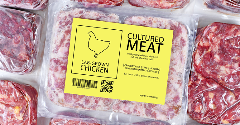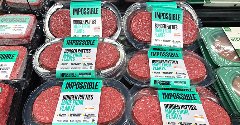News
SEE launches first biobased compostable protein trays
23 Feb 2024Sustainable packaging solutions for perishable food products have proved to be a big challenge for food manufacturers, but US packaging provider SEE (formerly Sealed Air) has launched a composable protein packaging tray.
SEE believes its latest offering for fresh meats and poultry businesses could make a difference.

The company launched the packaging tray at the IPPE event, held in Atlanta, Georgia, last month, and said it marked a major shift in fresh meat packaging as manufacturers look for alternatives to Expanded Polystyrene (EPS) solutions.
The biobased compostable protein tray is made from food-contact grade resin, certified by the United States Department of Agriculture (USDA). Derived from renewable wood cellulose the material breaks down naturally, leaving no chemical residue, the company said.
Providing a solution for a ‘pain point’
According to Tiffani Burt, SEE’s executive director for sustainability, digital and smart packaging, the Cryovac Overwrap Tray has been developed in response to a pain point for many of its customers who are under pressure from legislation requiring that are outlawing polystyrene materials.
“What we heard from our customers was that the other sustainable alternatives that they were testing and investigating had some critical failures or flaws, especially moving through processing,” said Burt.
“The wet and harsh nature of processing plants can prove challenging for some rigid packaging materials, like fibre-based moulded pulp solutions. Our tray was designed to withstand that, allowing the product to pass through distribution without impacting the shelf life.”
Answering the need for a durable and compostable solution
While ensuring the material had the durability to make it suitable for a range of processing environments, the other top priority was to ensure that it would be fully compostable.
“The trays are derived from a biopolymer that is made from cellulose,” said Burt. “That material is then processed using innovative proprietary extrusion technology to lightweight it, ensuring we use the least amount of material possible to do the job. And because of the material’s natural composition, it can compost in home composting bins as well as industrial composting solutions.”
SEE’s Cryovac Overwrap Tray is the latest solution to help meet the gradual phase out of polystyrene materials worldwide. The race to end the use of the material is seen as particularly urgent because its lack of biodegradability has also led to growing evidence that the material is contributing to the problem of microplastic pollution.
 © iStock/K Neville
© iStock/K Neville
Legislation is driving the race for alternatives
The EU, UK, Canada, Chile, New Zealand, and India are among more than 60 countries to impose legislation to phase out polystyrene. In the US the material has only been outlawed in 11 of the 50 states, while its use still goes largely unregulated in Asia, Africa, and Latin America – but pressure is mounting for a global ban.
Such legislation has prompted a big shift, particularly in the fast-food industry, which has relied heavily on single-use polystyrene-based packaging. Similarly, the legislation has also prompted fresh meat and poultry brands to find more sustainable alternatives for overwrap trays.
To meet this demand, a number of packaging providers have launched protein trays with enhanced recyclability, together with solutions that are based on Post-Consumer Recycled materials.
Compostable packaging is perceived by consumers to be one of the most environmentally-friendly solutions. This was underlined in a 2023 survey conducted by McKinsey, showing that consumers in 10 out of 11 major countries believed that compostable packaging materials are the most eco-friendly.
The need for greater sustainability
A 2019 study by the Fraunhofer Institute for Environmental Safety & Technology found that of the nine plastic materials that are used for meat and poultry trays – including PS, PET, PLA, XPS and PP – the XPS trays had the lowest environmental impact due to the use of mono materials, while multi-layered solutions had the highest impact.
The study also showed that none of these materials were proven to be in any way compostable, while only XPS trays were highlighted as having significant potential for recycling.
“There are several initiatives, actions and strategies within the EU and globally that aim to address the plastic waste problem. Nonetheless, it is unclear whether these strategies will contribute to overall sustainability or present an enhanced industrialised vision for recycling,” the study concludes.
Related news

UK consumers could be eating cultivated meat within two years
26 Mar 2025
Cell-cultivated products (CCPs), from chicken nuggets to beefburgers, could be on UK supermarket shelves by 2027 after regulators launched a sandbox to accelerate approvals.
Read more
Protein diversification: A massive missed market?
20 Feb 2025
Germany and the UK could be missing out on the massive market for alternative meats and proteins, with one new coalition calling for an end to the “steak-tofu struggle”.
Read more
Most consumers lack trust in AI, but supplement users are ready to embrace the technology
14 Feb 2025
A survey of UK and US consumers found that most supplement users are willing to let AI make decisions on their behalf, but they also demand greater transparency.
Read more
Indians enjoy first bites of cultivated chicken
13 Feb 2025
The first public tasting of cultivated meat in India has taken place as the country prepares for the first commercial cultivated meat products – potentially as early as the end of this year.
Read more
UK publishes latest food security report
12 Feb 2025
The UK government releases its food security report 2024, detailing five core themes for bolstering and securing the future of the country’s food.
Read more
Leading regulatory updates in Asia in 2025
7 Feb 2025
As we head into 2025, numerous legislators around Asia are suggesting and solidifying legal updates and changes that will impact the food and beverage space.
Read more
Singapore introduces Food Safety and Security Bill
3 Feb 2025
Amid growing food safety concerns and supply chain disruptions, the Singapore Food Agency passes its Food Safety and Security Bill (FSSB) to provide greater clarity, assurance, and credibility.
Read more
Impossible Foods secures reinstatement of EU patent for heme protein
28 Jan 2025
The decision overturns the 2022 revocation of the patent and solidifies legal protection of the innovative ingredient that can be used in plant-based food production.
Read more
US wins GMO corn trade dispute with Mexico
24 Jan 2025
A Mexican decree banning imports of genetically modified (GM) corn for human consumption has been overturned in what has been hailed as a victory for US exports.
Read more
EU Parliament passes stricter packaging rules
20 Jan 2025
The European Parliament voted to approve updates to the packaging and packaging waste regulation, including enforceable re-use targets, limits on certain single-use packaging types, and restrictions on the use of PFAS “forever chemicals”.
Read more